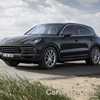Here we have it, then, Porsche’s all-new third-generation Cayenne and the most evolved of the sports SUV that properly kicked off the segment. Revealed, officially this time, at Porsche’s headquarters in Zuffenhausen, it introduces some new core technologies and key upgrades that they hope to keep at the business end of the pack for years to come.
While some might look at this Cayenne and proclaim that it doesn’t look all that new, we don’t quite agree, though do understand why that opinion would arise. Porsche does take an evolutionary approach to nearly everything they do, and in some important aspects this new version moves the game along considerably.
That game, though, as we suspected, is cherry-picked from the repertoires of their own cars as well those from other vehicles within the Volkswagen Group - we’ll explain as we go. In terms of design, yes, there is some strong resemblance to the previous generation Cayenne, but then again why wouldn’t there be?
Aside from that obvious comparison, there’s also more flavour of the smaller Macan thrown in as well as some visual reference made to the Panamera, particularly in the Sport Turismo bodystyle. Under the skin, the Cayenne rides upon the MLB platform that also underpins the Audi Q7 and Bentley Bentayga, and in the future will form the basis for the next Volkswagen Touareg and Lamborghini’s inaugural SUV, the Urus, finally emerging from production limbo.
There’s certainly more of an inherently car-like vibe to the new Cayenne. It looks like wagon that rides higher, half-stepping away from the more traditional proportions of an SUV. Porsche says that they wanted to “accentuate the character of the vehicle. More Porsche, more Cayenne,” - whatever that means. They also say that they drew from their premier sports car, the 911, to inform the third-generation Cayenne, but we struggle to find that through line.
Thanks to more emphasis on aluminium both in its body construction as well within that new platform, weight has been reduced by over 60kg at the minimum over an equivalent variant of the older model, while dimensionally it remains almost identical. Torsionally, there’s less flex in the chassis, allowing Porsche to delve deeper into reducing the handling gap between it and its proper sports models.
They are rather proud of how it drives, it would seem, with plenty of calibration work going into the new double wishbone front and multi-link rear suspension setup and how they interface with the adaptive dampers, torque vectoring (via the all-wheel drive system) and active roll bars. Optionally, it even comes with rear-wheel steering, something only introduced into the modern Porsche lexicon with the Type-991 GT3 in 2014.
Initially, the 2018 Porsche Cayenne will be available in two variants (though that’s not likely to last very long): the standard Cayenne and higher-end Cayenne S. Both come with turbocharged V6 engines, however unequal, as the base model uses the carryover 3.0-litre that develops 250kW and 450Nm while the S receives the more advanced 2.9-litre V6 turbo co-developed with Audi (and is currently being used in the RS5, among others) that generates 324kW and 550Nm.
Mated to an identical - but new - 8-speed automatic tranmsision, both are of course plenty fast off the line, with the 100km/h mark arriving in 5.2- and 4.9-seconds respectively. Per the gentlemen’s agreement among German automakers, top speed is limited to 265km/h.
Inside, the more modern dashboard really does take centre stage in the new Cayenne as it did with the Panamera - a bevy of buttons are replaced by a cleaner set of capacitive touch points spread over the centre tunnel around the gear selector. North of that we have the very wide 12.3-inch HD touchscreen Porsche Communication Management (PCM) system that comes with voice control, real-time traffic information, and online navigation.
This ties into the pair of 7-inch circular displays that flank the main tachometer analogue dial in the instrument cluster, letting the driver select from multiple information view presets most relevant or preferred at that time. Porsche then offers the option of having audio emerge from new sound systems from either Bose or Burmester.
Obviously, there’s plenty more that Porsche isn’t yet choosing to reveal about their all-new Cayenne, especially about the expanded variants such as the GTS, Turbo, and Hybrid and the new features it will boast above these two detailed here. It’s very possible that the ensemble here will, for the most part, mirror the second-generation Panamera, with the range-topper being a Turbo SE Hybrid with 500kW.
Suppose we’ll have to wait for more at the Frankfurt Motor Show next month.
































